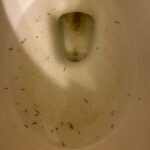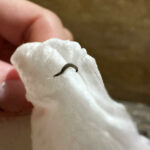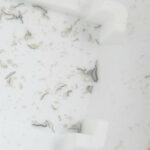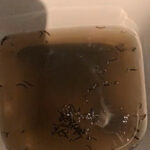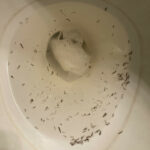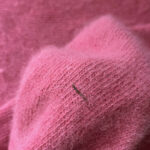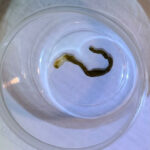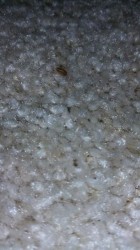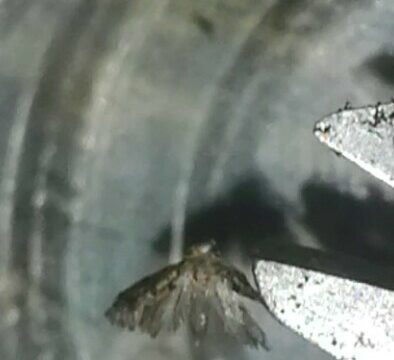
“I purchased mystery snails and one laid a clutch”, writes Jessica about the black, worm-like critter pictured below, as well as the clear-white objects, also pictured below. “Well, I thought it was hatching last night, and these tiny shell-less, slug-like, tiny, black worms were inside. Only like five of them, but they have antennae and kinda the same ribbed look as the snail’s siphon. They kinda move in an ‘inch worm motion’. Not sure if they prefer water habitats, but they are inside an empty aquarium and seem to be able to survive and swim. Are these the newborn snails? They don’t look like them, because they have no shell.”
To answer Jessica’s question right off the bat, these are not newborn snails, but drain fly larvae. Their segmented bodies, bigger heads, and antennae give them away. Drain fly larvae are not harmful to humans, and they should not be harmful to snails either, as far as we know. They are not predators, but detritivores, meaning they eat decomposing organic materials, just like earthworms and millipedes. We think it’s possible that the larvae are eating some organic materials in the clutch, though whether or not this is compromising the health of the unborn snails, or their chance at hatching, we cannot say. To be safe, we recommend that Jessica remove the drain fly larvae, and that she move the clutch somewhere where the drain fly larvae are less likely to gain access to them.
As their name suggests, drain fly larvae come from drains. And by that we mean that they are actually born in them. The mother drain fly will lay her eggs on the organic film that typically forms in the lip of a drain, and they spread from there. They are often seen crawling up the walls of a shower or bathtub, searching for food. To eliminate drain fly infestations, preventative measures are key. This includes routinely running water through the taps and flushing the toilet (even if it is not often used, like in a guest bathroom) to prevent the water from becoming stagnant, cleaning one’s drains often (making sure to scrub the organic film away – this is the most important step!), and sealing any openings in the home through which flies could enter (cracks in walls and floors, and tears in window screens). When it comes to the larvae already in the home, we suggest moving them outside, where they will happily find plenty of food to eat.
To conclude, the black worms Jessica found in her snail’s clutch are not newborn snails, but drain fly larvae. They are not harmful to humans, though we do not know if they would be harmful to the health of the unborn snails. We hope this helps, and wish Jessica, as well as her snail(s), the very best!
All About Worms is always free, always reader-supported. Your tips via CashApp, Venmo, or Paypal are appreciated! Receipts will come from ISIPP Publishing.
You might also find these guys interesting!






